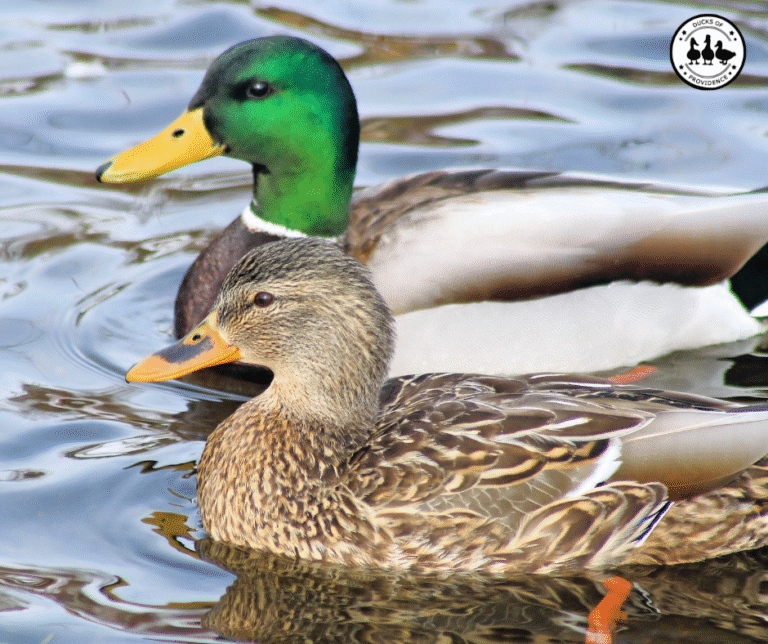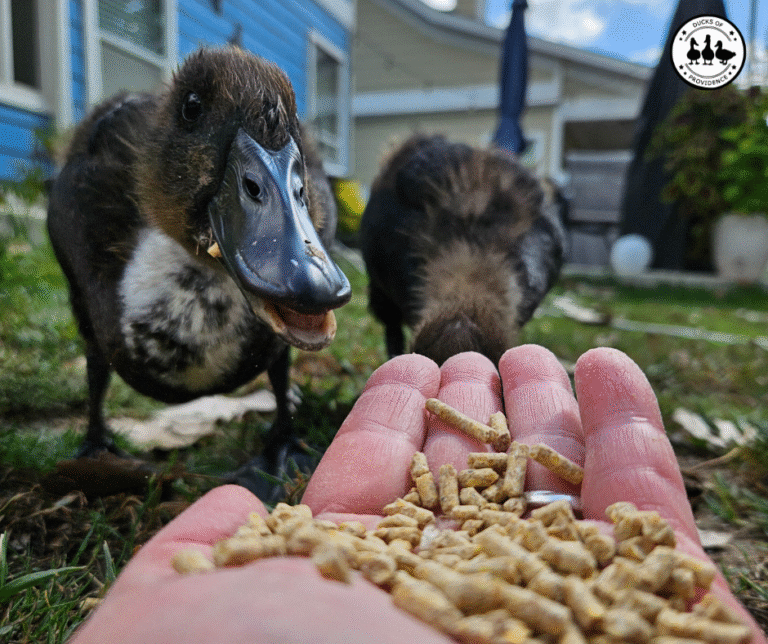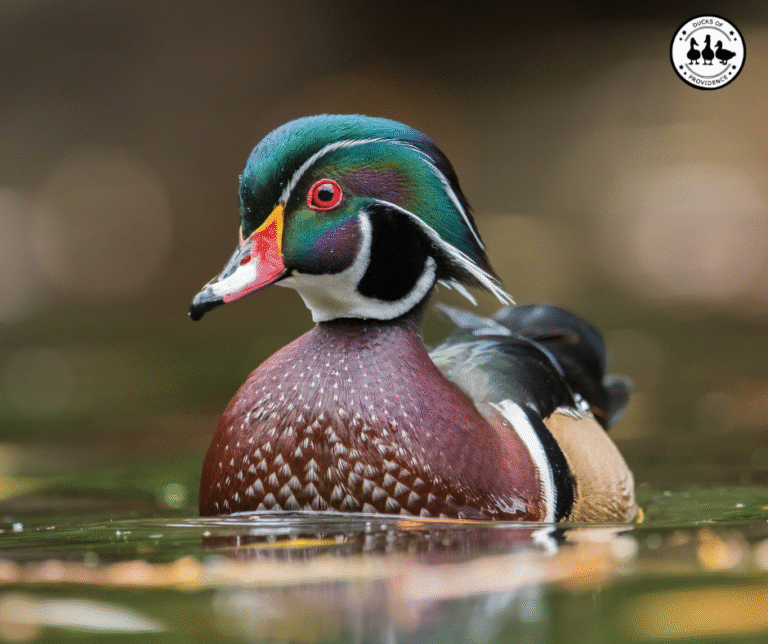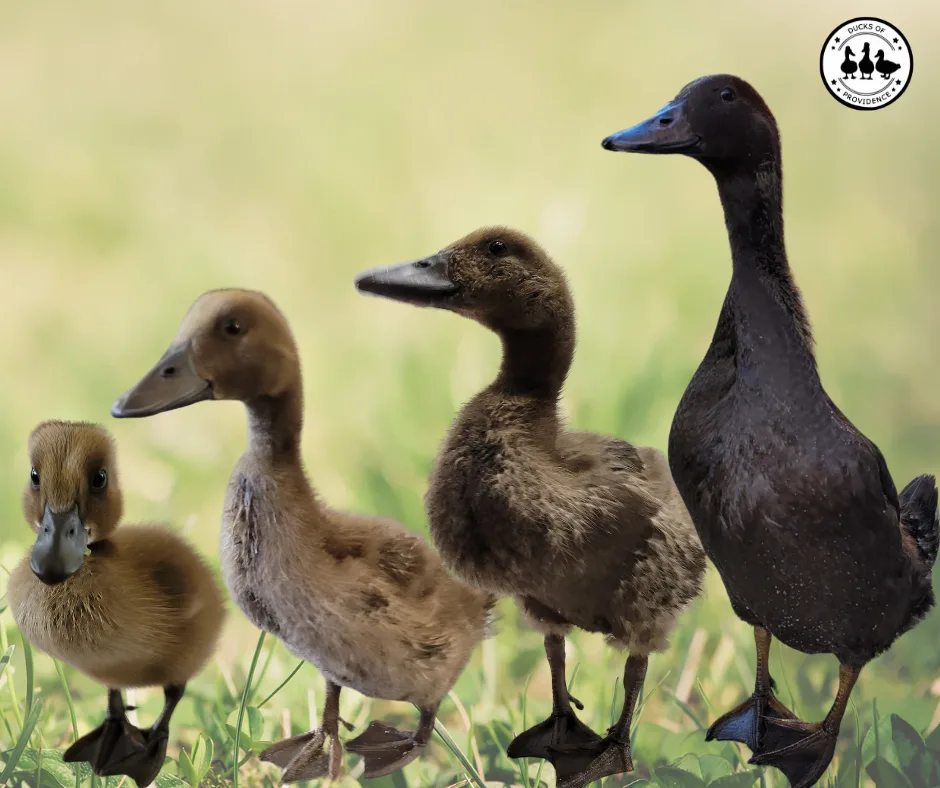
How Old Is My Duck in Human Years? A Guide to Duck Life Stages
Have you ever wondered how your duck’s age compares to a human’s? Ducks grow and mature incredibly fast, reaching key life milestones much sooner than we do. While it’s not a perfect science, we can compare duck life stages to ours based on development, maturity, and lifespan.
In this guide, we’ll break down each stage of a duck’s life and its approximate human-age equivalent to help you understand how quickly your feathered friend grows.
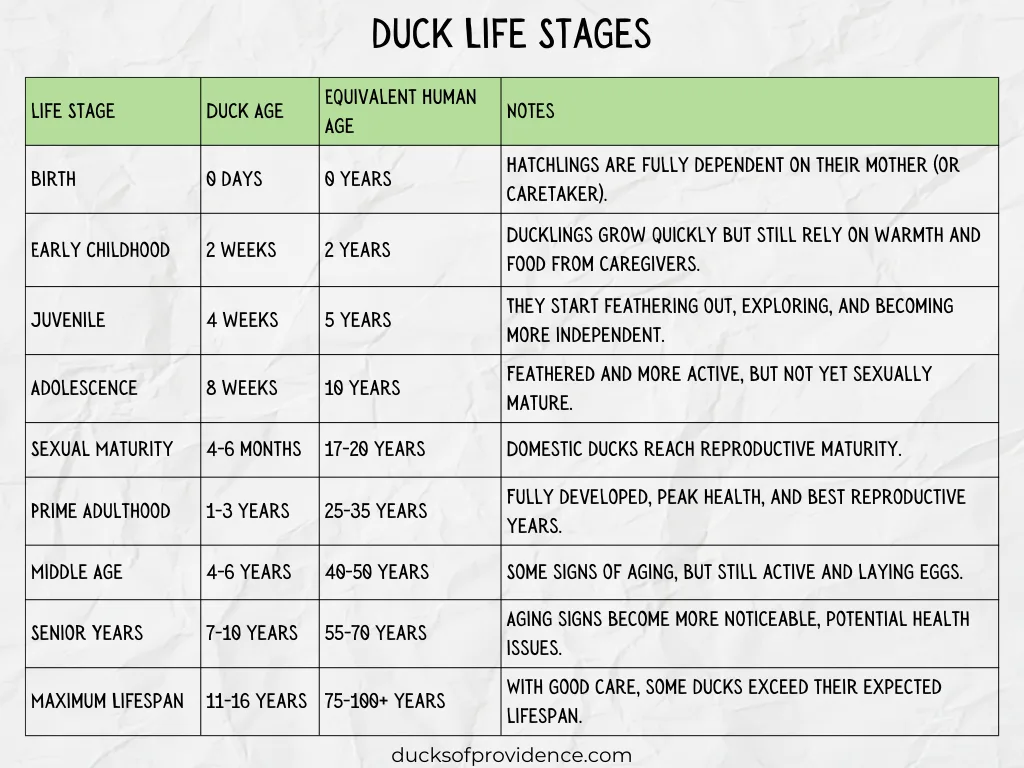
Ducks of Providence is free, thanks to reader support! Ads and affiliate links help us cover costs—if you shop through our links, we may earn a small commission at no extra cost to you. Thanks for helping keep our content free and our ducks happy! 🦆 Learn more
From Hatchling to Adulthood: The Fast-Paced Life of a Duck
Ducks grow incredibly fast, transforming from fragile hatchlings to independent juveniles in just a few short weeks. Their rapid development means they experience life stages much faster than humans, making every moment with them feel even more precious. Let’s explore how their journey compares to ours.
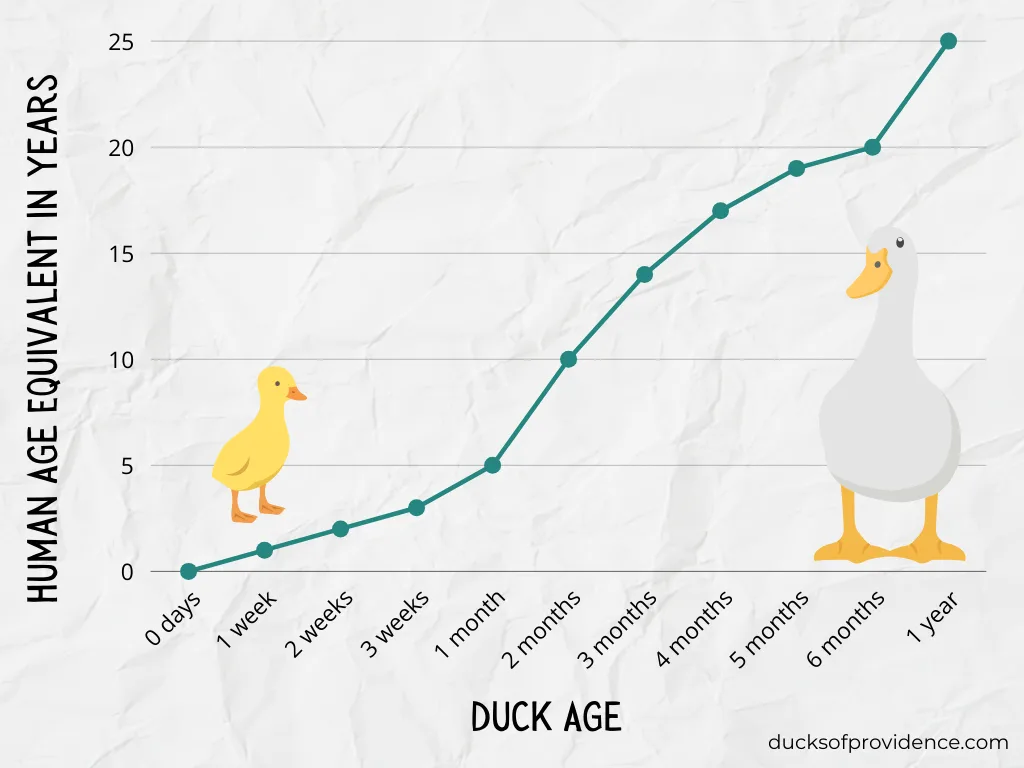
Birth: 0 Days (Human Equivalent: 0 Years)
A duckling hatches from its egg after about 28 days of incubation, though this can vary slightly depending on the breed. At this stage, they depend completely on their mother (or YOU, their human caretaker) for warmth, safety, and guidance—much like a newborn baby.

Despite their tiny size, ducklings are precocial, meaning they hatch with their eyes open and are covered in soft down rather than being naked and helpless like many other bird species. Within hours of hatching, they can walk and swim, instinctively following their mother or human to stay safe. However, their bodies are not yet fully developed, and they lack the ability to regulate their own body temperature efficiently. This is why they rely on external heat sources, whether from a broody mother duck or a heat lamp/plate in a brooder.
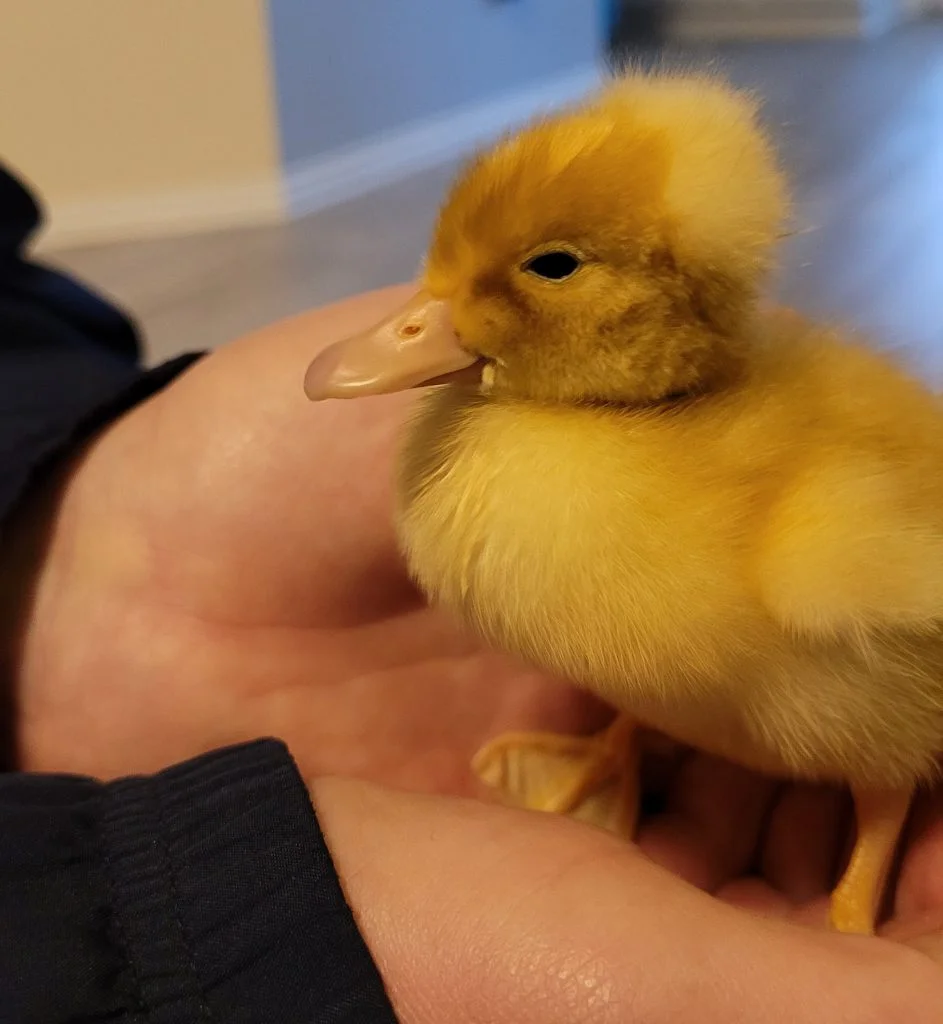
At this stage, they imprint strongly on their caregiver, forming a bond that influences their behavior and sense of security. Providing a warm, draft-free environment, access to clean water (in a shallow, safe dish), and a high-quality, protein-rich starter feed is essential for their survival and healthy development.
Early Childhood: 2 Weeks (Human Equivalent: 2 Years)
In just two short weeks, ducklings undergo a remarkable growth spurt. Their soft down begins to be replaced with the first signs of juvenile feathers, especially on their wings and tails. Though they are still covered mostly in fluff, their bodies are getting stronger, and they become more active and adventurous.

This stage is much like a human toddler exploring the world—full of curiosity but still needing close supervision and guidance. Ducklings at this age eagerly investigate their surroundings, nibbling at everything and practicing essential behaviors like dabbling in water, preening, and foraging for food. They can swim more confidently, but since their oil glands are not fully developed, they still rely on their caretaker to ensure they don’t get waterlogged and chilled.

While they are becoming more independent, they still require warmth, as their ability to regulate body temperature is improving but not yet fully developed. At this stage, their diet remains high in protein to support their rapid growth, and they start developing their own unique personalities, whether it’s being extra bold, extra clingy, or the troublemaker of the group.
Juvenile Stage: 4 Weeks (Human Equivalent: 5 Years)
By the time ducklings are one month old, they have transformed from fragile hatchlings into confident little explorers. Their bodies have grown significantly, and they are much sturdier on their feet. At this stage, their personalities start to shine—some may be bold and adventurous, while others remain more cautious and clingy.

This stage is similar to a human preschooler, full of boundless energy and curiosity. Just like a five-year-old child testing their independence, ducklings at this age love to explore their environment, often pushing boundaries while still relying on their caretaker for protection and guidance. They engage in playful behaviors, chase after moving objects (or each other), and even exhibit early signs of pecking order dynamics as they establish their place in the flock.
Although they are much more independent, they still need supervision. Their fluffy down is gradually being replaced with juvenile feathers, but since they are not fully feathered yet, they remain vulnerable to cold weather and wet conditions. Similar to how young children still need extra care against the elements, ducklings require a warm, dry space when the temperatures drop.
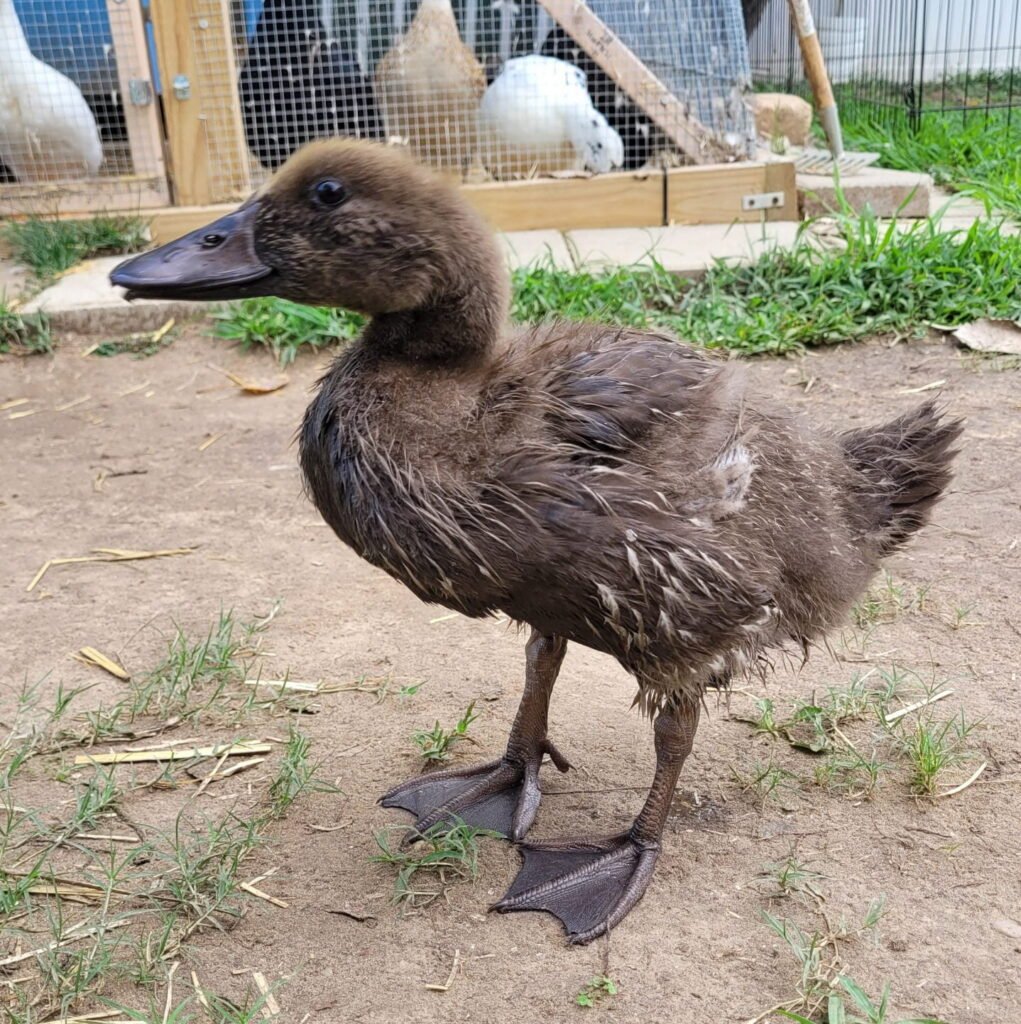
At four weeks old, ducklings are highly active, eagerly foraging, playing in water, and mimicking adult duck behaviors. They also begin testing their wings, flapping enthusiastically—like a child pretending to “fly”—even though they aren’t yet capable of actual flight. Their diet continues to support their rapid growth, transitioning to a lower-protein feed as they approach their next developmental milestone.
Adolescence: 8 Weeks (Human Equivalent: 10 Years)
At two months old, ducks are in their adolescent stage—nearly full-sized and beginning to resemble their adult selves. Their bodies have filled out, and most have shed their fluffy down in favor of sleek juvenile feathers. While they may not have their final adult plumage yet, they are well on their way.
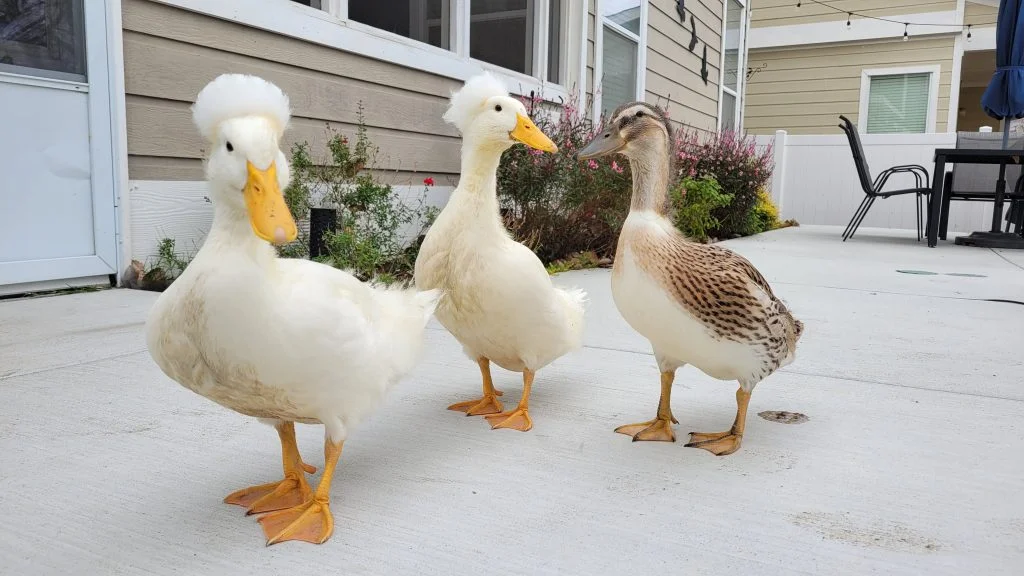
This stage is comparable to a 10-year-old child—gaining independence and testing limits but still needing structure and guidance. Like preteens who are eager to do things on their own but aren’t quite ready for full independence, ducks at this age are strong swimmers, confident foragers, and capable of handling more of their daily needs. However, they still rely on their caretakers for food, protection, and a safe environment.
By now, they are much better at regulating their body temperature, and fully feathered ducks can safely spend more time outdoors, even in cooler weather. Their personalities are well-developed, and social dynamics within the flock become more apparent, with ducks asserting themselves and solidifying their place in the pecking order.
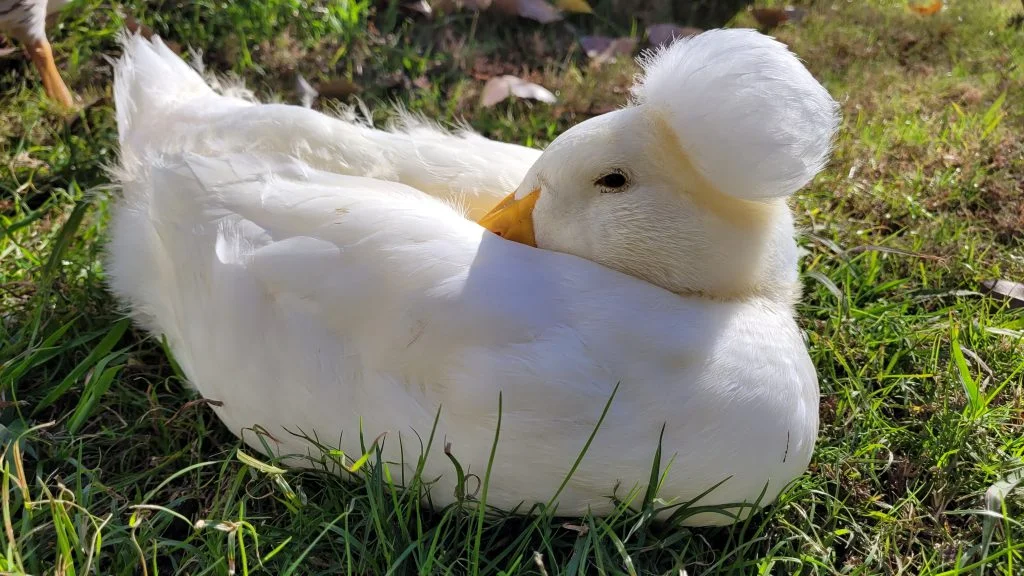
At this stage, their diet transitions further, with a shift toward lower-protein maintenance feed to support healthy growth without encouraging excessive weight gain. Some breeds may even start showing early signs of gender differences, such as changes in voice—males develop a raspier quack while females have a louder, clearer call.
Much like human preteens who are full of energy and always on the move, adolescent ducks are highly active, flapping their wings, running, and playfully chasing each other. They may even make their first awkward attempts at flying—short bursts of flapping and lifting off the ground, much like a child learning to ride a bike without training wheels for the first time!
Sexual Maturity: 4-6 Months (Human Equivalent: 17-20 Years)
This is a major milestone in a duck’s life—by 4 to 6 months of age, they have officially reached sexual maturity. At this stage, female ducks (hens) begin laying their first eggs, while males (drakes) start exhibiting courtship behaviors. Their adult plumage is fully developed, with drakes of certain breeds showcasing their distinct, vibrant colors.
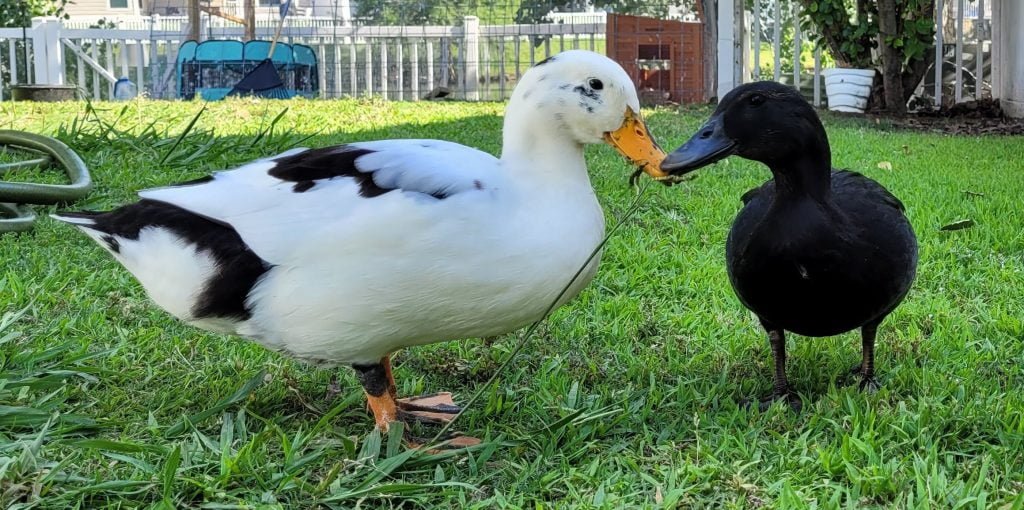
This stage is comparable to a human reaching adulthood at around 17-20 years old. Just like young adults stepping into the responsibilities of grown-up life, ducks at this age are fully independent, capable of finding food, establishing social roles, and, if allowed, starting to breed. Their personalities are completely formed, and any quirks or habits they displayed as ducklings have now solidified. Some may be friendly and social, while others might be more dominant within the flock.
Hens typically start laying small or irregular eggs at first as their reproductive systems adjust, much like how humans go through changes during early adulthood. Their egg production will soon become more regular, with breed and season playing a role in their laying frequency. Drakes, on the other hand, become more territorial and protective, sometimes displaying aggression, especially during the breeding season.
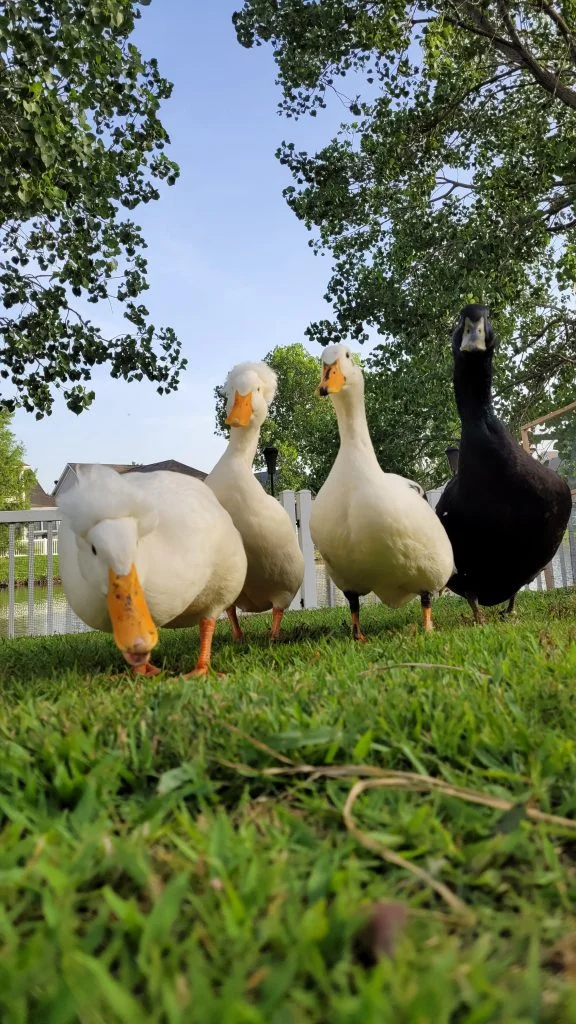
By this time, their diet shifts fully to adult maintenance feed to support long-term health. They no longer require the high-protein diet of their fast-growing juvenile months, but they still benefit from calcium supplements (for laying hens) and a well-balanced diet to maintain their energy levels.
Much like young adults who have found their footing in the world, sexually mature ducks are confident, independent, and fully integrated into their flock’s social structure. They are now officially grown-ups in the duck world!
The Prime of Life: Adulthood and Middle Age
Ducks in their prime are full of energy, thriving in their environment and at their healthiest. This stage marks a time of stability and routine, where they enjoy the benefits of maturity without the limitations of old age. Unlike their early growth stages, which happen rapidly, adulthood and middle age in ducks progress much more linearly. On average, one duck year equals approximately five human years.
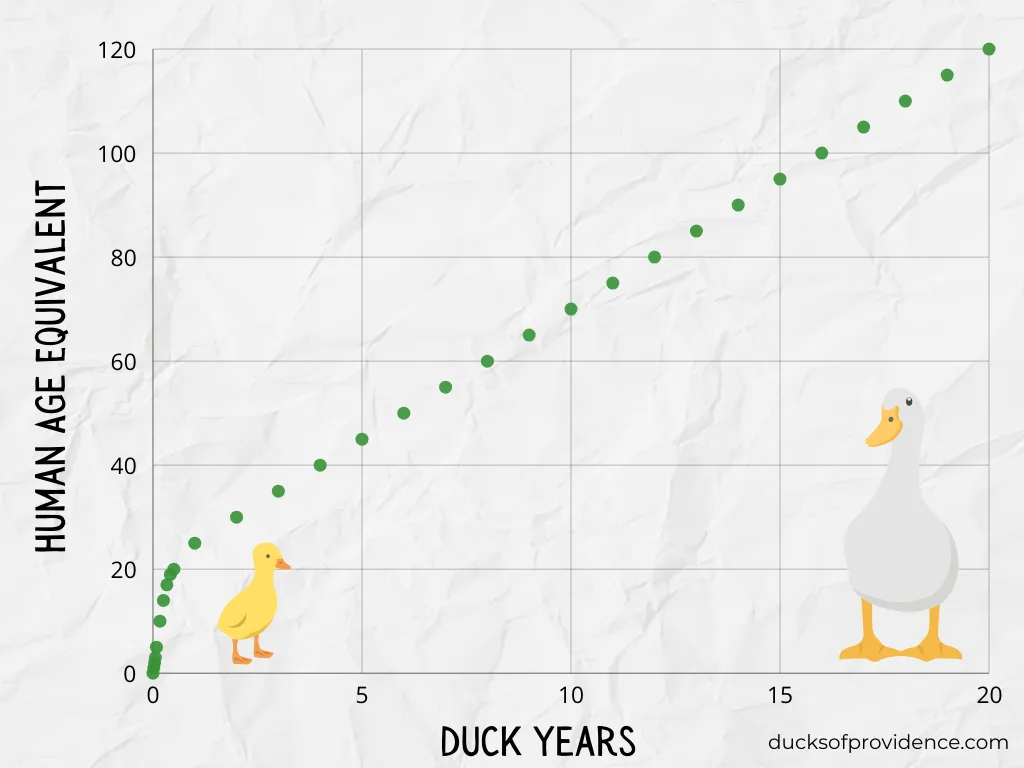
Prime Adulthood: 1-3 Years (Human Equivalent: 25-35 Years)
Your duck is now in its prime years! Fully matured and well-adjusted, they are at their healthiest, most active, and, if female, are laying eggs regularly. This stage is the equivalent of a human being in their 20s and 30s—full of energy, physically at their peak, and thriving in their daily routines.
For laying hens, egg production is at its highest during this period, with a consistent laying cycle depending on breed, diet, and daylight hours. Their eggs are typically larger and more uniform than during their first year. Drakes, meanwhile, are at their most robust, displaying strong breeding behaviors during mating seasons and maintaining a well-defined place within the flock’s hierarchy.

Much like humans in their prime working years, ducks have established habits and personalities at this stage. They know their environment, caretakers, and fellow flock members well. These traits remain stable whether they are playful, bossy, affectionate, or independent. They are also highly social and engaged, interacting confidently with other ducks and even humans if they were raised around people.
Since they are at their healthiest, proper nutrition and regular observation help maintain their well-being. A balanced diet rich in essential nutrients, along with fresh water and occasional treats, supports continued egg-laying and overall vitality. Ducks in their prime years may still be highly active, enjoying foraging, swimming, and socializing, but they also appreciate routine and the security of their established flock dynamics.
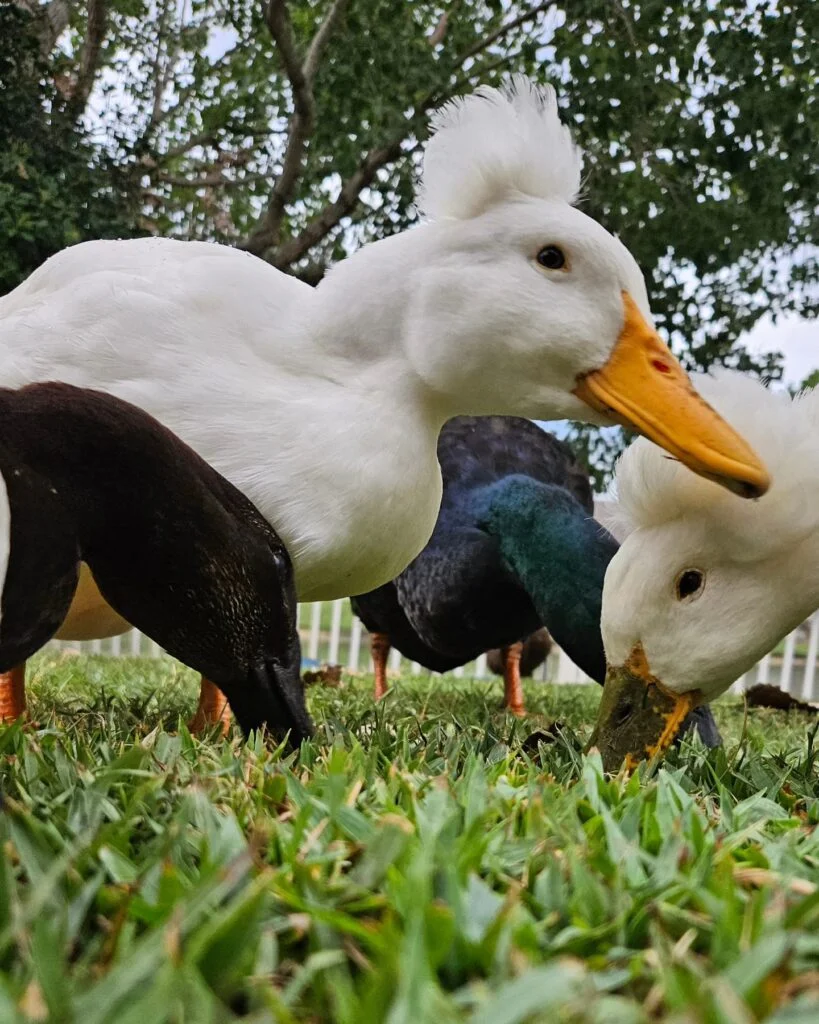
Just like humans in their 20s and 30s, prime-age ducks are resilient and adaptable, but they also benefit from good care to ensure a long, healthy life beyond their peak years.
Middle Age: 4-6 Years (Human Equivalent: 40-50 Years)
As ducks enter middle age, they may start to slow down slightly, but they remain active, social, and engaged in their surroundings. This stage is comparable to a human in their 40s and 50s—still vibrant and capable but beginning to experience the first signs of aging.
For female ducks, egg production often starts to decline. While they may still lay regularly, the frequency and consistency vary, and eggs may become smaller or have thinner shells. Some hens may even take longer breaks between laying cycles. Drakes, while still maintaining their roles in the flock, may not be as aggressive or energetic as in their younger years.
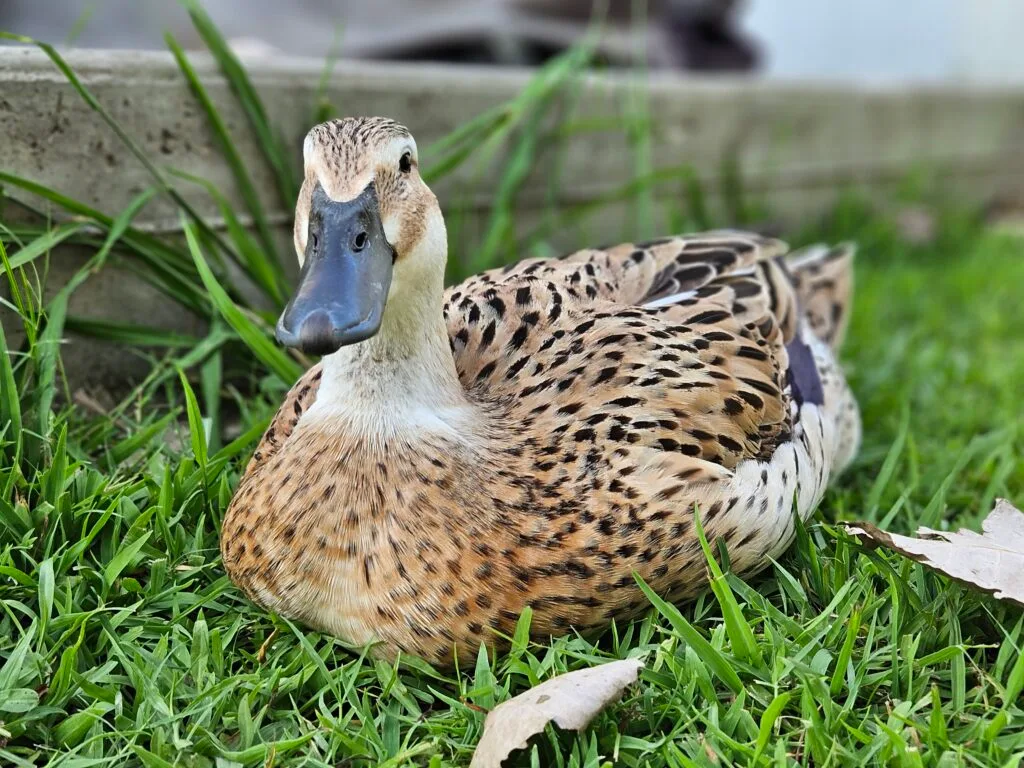
Physically, middle-aged ducks may begin to show subtle signs of aging. Their feathers might not be as sleek as before, and they could take longer to molt and regrow new plumage. Interestingly, some breeds, like Cayugas, start developing white feathers as they age—just like humans getting gray hair! While this change is purely cosmetic and doesn’t affect their health, it’s a fascinating visual sign of their advancing years.
Some ducks may also experience mild joint stiffness, especially in larger breeds, and their activity levels may decrease slightly. However, many middle-aged ducks remain strong swimmers and foragers, enjoying their usual routines with only minor adjustments.

Just like humans in middle age who focus more on maintaining their health, proper diet and care become increasingly important. Providing nutrient-rich feed, calcium supplements (for layers), and access to clean water helps keep them in top shape. Monitoring for early signs of arthritis or other age-related conditions can also ensure they continue to live a comfortable life.
Although they may not have the same boundless energy as their younger selves, middle-aged ducks still enjoy socializing, exploring, and spending time with their flock. They are experienced, confident, and well-adapted to their environment, much like a person who has settled into the rhythm of life with wisdom and familiarity.
Senior Years: Aging Ducks and Their Golden Years
As ducks enter their senior years, their once-fast-paced life begins to slow down. While their earlier stages were marked by rapid growth and boundless energy, aging follows a more predictable trajectory. Just like humans, ducks start showing signs of aging gradually, and their care needs evolve to match their changing bodies. Since one duck year is roughly equivalent to five human years, a 10-year-old duck is like a 70-year-old person!
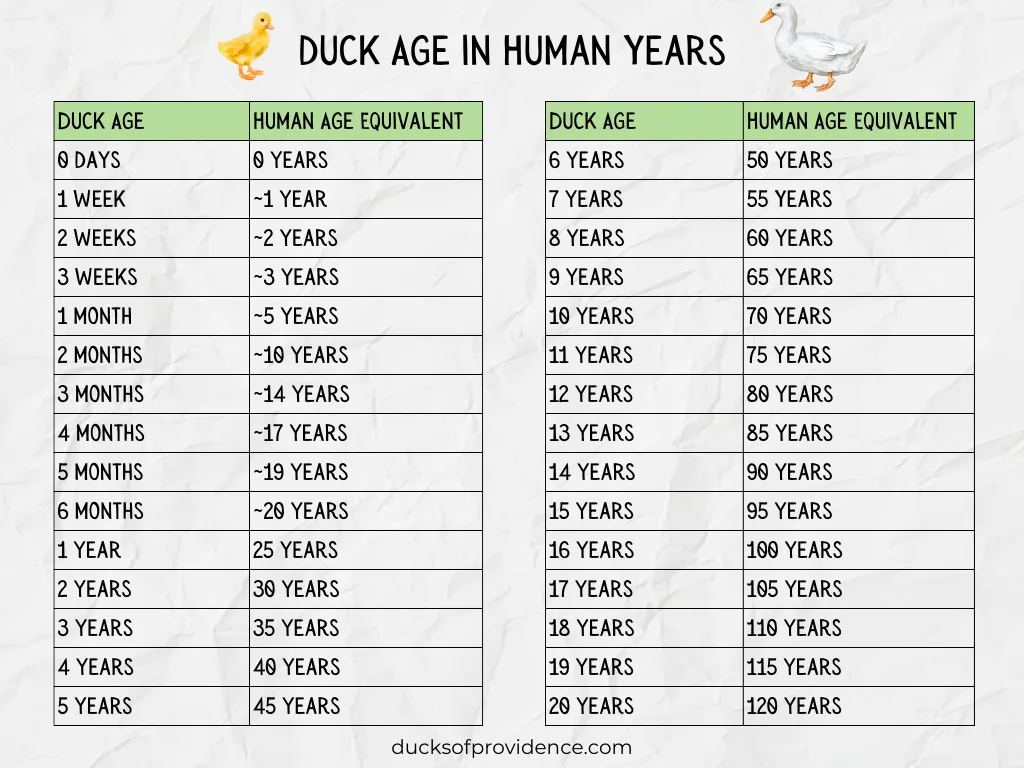
Senior Years: 8-12 Years (Human Equivalent: 60-80 Years)
Ducks in their senior years may start to slow down noticeably, much like humans in their 60s to 80s. They may spend more time resting, waddle a little slower, and show visible signs of aging. However, with proper care, many senior ducks continue to live happy and fulfilling lives well into their golden years.
Joint stiffness is one of the most common age-related changes, particularly in heavier breeds. Arthritis can set in, making movement more difficult, especially in cold or damp weather. Providing soft bedding, shallow water sources for easy access, and ramps instead of steps can help them stay comfortable.

Feather quality may also decline, and molting might take longer than it did in their younger years. Some ducks, like Cayugas, will continue to develop more white feathers as they age—just like humans getting gray hair. This is a natural and expected part of aging and gives each duck a unique, distinguished look.
For female ducks, egg-laying may stop altogether or become very sporadic. Their bodies prioritize overall health over reproduction, much like post-menopausal humans. Drakes may become less territorial and mellow out, spending more time lounging rather than asserting dominance.
Since older ducks are more prone to age-related health issues, regular check-ups and a nutrient-rich diet tailored to senior ducks can help maintain their quality of life. Extra vitamins, joint supplements, and soft, easy-to-eat foods can support their aging bodies. Keeping a close eye on their weight is also important—some older ducks may lose muscle mass, while others may gain excess weight due to reduced activity.
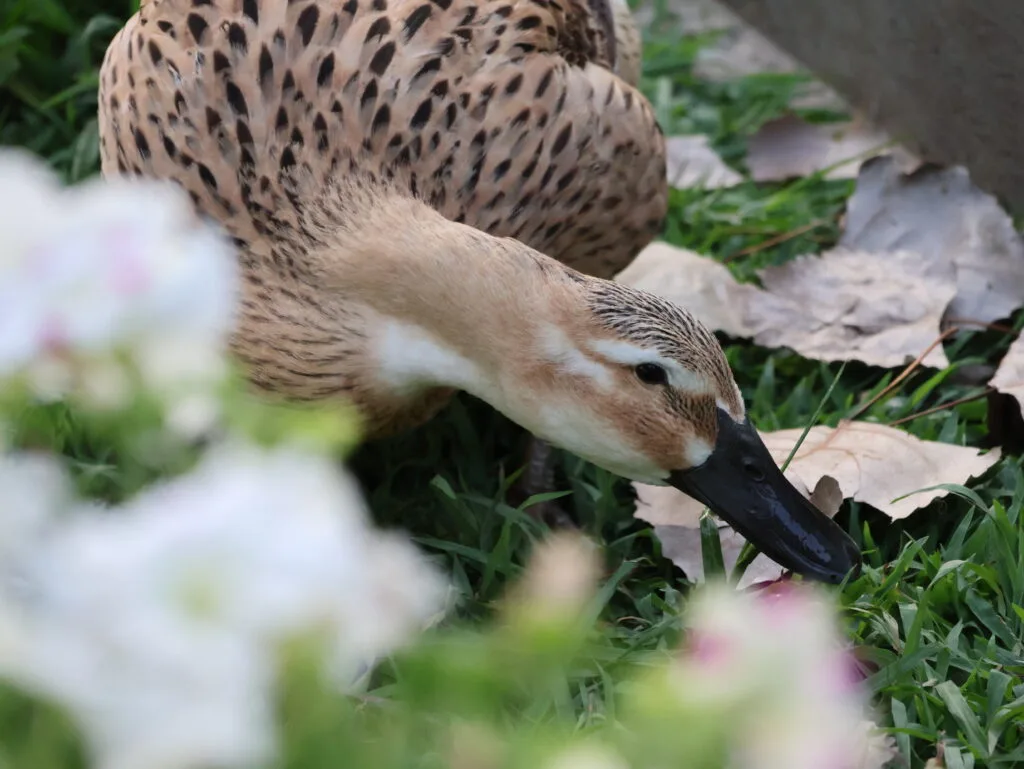
Despite slowing down, senior ducks still enjoy companionship and routine. They may not be as adventurous but appreciate familiar faces, gentle interactions, and peaceful surroundings. With a bit of extra care, these wise old ducks can continue to enjoy their golden years with dignity and comfort.
Maximum Lifespan: 12-17 Years (Human Equivalent: 80-100+ Years)
With proper nutrition, shelter, and veterinary care, ducks can live well beyond their expected lifespan. While the typical lifespan of a duck is around 10 years, many ducks have been known to live 16 years or even longer. This would be the equivalent of a human reaching 100+ years old!
As ducks reach their maximum lifespan, they may experience more significant health issues due to age, but with the right care, many can continue to enjoy a good quality of life. Their feathers may become increasingly sparse, and their mobility might be limited due to arthritis or other age-related conditions. However, these ducks can still be affectionate, enjoy gentle company, and even engage in light foraging or swimming.

At this stage, providing a highly supportive environment becomes essential. A senior-friendly setup with easy access to water, soft bedding, and extra warmth can ensure their comfort. Frequent check-ups, appropriate joint care, and a balanced diet are vital to support their aging bodies.
Some ducks live well into their maximum lifespan with few health problems, while others may need more intensive care as they age. Regardless, these elderly ducks are a testament to the importance of providing them with the best care possible throughout their lives. With proper attention, ducks can thrive well into their senior years and enjoy their final years with dignity, contentment, and a lot of love.
Coping with the Loss of Your Duck
Losing a beloved duck can be the hardest part of pet parenting. Ducks become not just animals in your care but beloved family members. If you’ve spent years watching them grow, providing for them, and sharing daily moments, their loss can leave a deep emotional gap. The grief of losing a duck can feel overwhelming, especially when you’ve nurtured them from the first day they hatched to their final days.
When a duck passes away, it’s natural to feel a mix of sadness, confusion, and even guilt. You may question if you did enough for them, or feel a sense of emptiness because their presence was such an integral part of your daily life. It’s important to remember that your care and love gave them the best life possible, and their time with you was filled with affection and security.
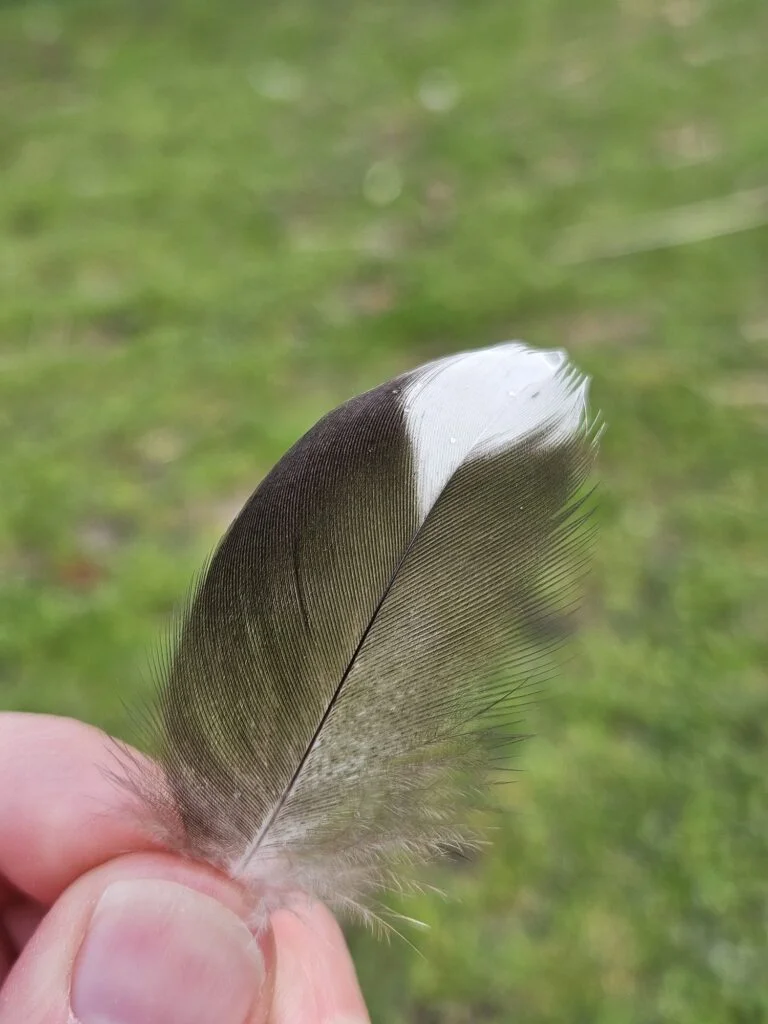
If you’re struggling with the grief of losing your duck, know that you’re not alone. This is a process that takes time, and it’s okay to feel upset. The bond you shared with your duck was special, and it’s natural to grieve the loss of a pet who has brought so much joy to your life.
For a more in-depth exploration of dealing with the grief of losing a duck, be sure to check out our other post, Handling Your Duck’s Passing: Coping with Loss. It delves deeper into the emotional journey of loss and offers tips on how to honor your duck’s memory, navigate the grieving process, and eventually heal. While the pain of loss can never be fully erased, time and support can help you remember all the wonderful moments you shared with your feathered friend.
Why This Matters for Duck Owners
Understanding the life stages of ducks helps us provide the best care for them at every step of their journey. Knowing that a 6-month-old duck is like a young adult or that a 10-year-old duck is a senior citizen can guide us in adjusting their diet, habitat, and medical care accordingly. From the fragile, dependent ducklings to the mature adults and their eventual senior years, each phase is an opportunity to offer the care and attention your duck needs to thrive.

No matter what stage of life your duck is in, they rely on you to keep them happy and healthy. Ducks teach us the importance of patience, understanding, and attentiveness. Whether they’re at their peak in their prime adulthood or slowing down in their senior years, their unique personalities and changing needs are constant reminders of the bond you share. Enjoy every moment with your feathered friend—because just like in humans, duck years fly by!
When the time comes to say goodbye, remember that the love and companionship your duck brought into your life will always be cherished. Losing a beloved pet is never easy, but the memories of their joy and the lessons they’ve taught us will remain forever.
What stage is your duck in? Let me know in the comments below!


